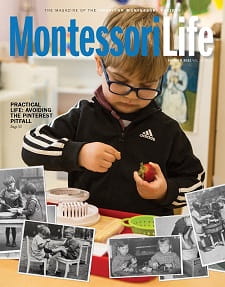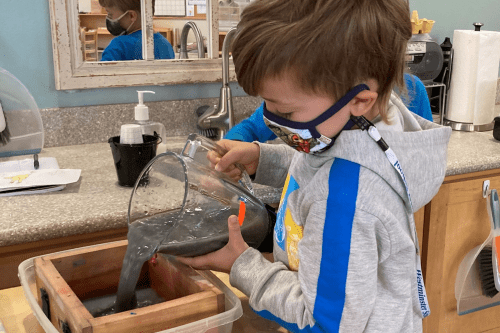 Respect for the environment and conscientious care for the world around us are fundamental elements of Montessori philosophy. In learning how to leave the things they use “ready for the next person” instead of merely how they found them, children incorporate the practice of environmental stewardship and sustainability into their daily lives. Montessori believed that as children learned about ecology and the life systems of the world, they would observe the natural systems that “carry out an enormous work serving the harmonious upkeep of the earth. [Each part] has a purpose, a special aim to fulfill and the result of these tasks is our beautiful world” (2009, p. 52). Both within and beyond the classroom, Montessori’s philosophy aligns broadly with practices of environmental education as it leads toward sustainable living, and internalizes an ethos of mindfulness that underpins children’s future activities and intentions.
Respect for the environment and conscientious care for the world around us are fundamental elements of Montessori philosophy. In learning how to leave the things they use “ready for the next person” instead of merely how they found them, children incorporate the practice of environmental stewardship and sustainability into their daily lives. Montessori believed that as children learned about ecology and the life systems of the world, they would observe the natural systems that “carry out an enormous work serving the harmonious upkeep of the earth. [Each part] has a purpose, a special aim to fulfill and the result of these tasks is our beautiful world” (2009, p. 52). Both within and beyond the classroom, Montessori’s philosophy aligns broadly with practices of environmental education as it leads toward sustainable living, and internalizes an ethos of mindfulness that underpins children’s future activities and intentions.
In this article, I will focus on one aspect of environmental stewardship and sustainability: embracing solid waste reduction by reducing material consumption and by reusing and recycling used materials. These activities can make the abstract concepts of reducing, reusing, and recycling more concrete for young children, as they turn waste products back into attractive, meaningful objects and learn to see solid waste as a resource for creative reuse.
The ultimate goal of environmental education work is to develop good habits both in and beyond the classroom, so that as children grow, they do not think of themselves as making a special effort or taking an extra step beyond their normal activities to be “green.” Instead, the discipline of sustainable practice is integrated deeply into their sense of care for the physical environment as a life practice.

The opinions expressed in Montessori Life are those of the authors and do not necessarily represent the position of AMS.
On this page


